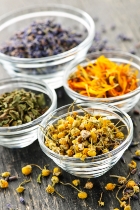 Phytotherapy is the use of medicinal plants to heal and restore balance. Even though phytotherapy is an age-old tradition, new research is being published all the time showing how plant molecules act to balance hormones naturally.
Phytotherapy is the use of medicinal plants to heal and restore balance. Even though phytotherapy is an age-old tradition, new research is being published all the time showing how plant molecules act to balance hormones naturally.
Many herbs have been used traditionally by herbalists and women for decades, and in some cases centuries, to address menopausal symptoms. Many women are still unsure about herbs and whether they're safe, or afraid that herbal remedies just won't work.
However phytotherapy can be a gentle and effective way to restore hormonal balance and help relieve symptoms.
Ten of the most common herbs used to treat menopausal symptoms are as follows. Herbalists, homeopaths or pharmacists may be able to help you with which may suit you.
Black Cohosh
(Actaea racemosa)
Native to Eastern North America, black cohosh has been used by women for generations and is especially helpful for alleviating menopausal symptoms such as hot flashes, mood swings and insomnia. It is thought to act as a hormone imitator, binding to opioid receptors in the brain, and possibly influencing serotonin levels.
Red Clover
(Trifolium pratense)
Rich in phytoestrogens including lignans, coumestans, and isoflavones which help normalise estrogen action. This makes red clover a helpful herb for menopausal symptoms, especially night sweats.
Chastetree
(Vitex agnus-castus)
Chastetree is especially helpful in perimenopause, helping to regulate the menstrual cycle, which is one way it may enhance progesterone production in the body.
Kudzu
(Pueraria lobata)
A member of the pea family, native to Asia. Much like red clover, kudzu contains phytochemicals that function in a protective fashion. These include five major isoflavonoids that can bind weakly to estrogen receptors, which can compensate for the effects of low estrogen levels in menopause.
Passionflower
(Passiflora incarnata)
Has strong Native American roots and contains natural monamine oxidase inhibitors (MAOIs), which are known to have antidepressant and anti-anxiety properties. Passionflower is especially helpful for irritability, anxiety, or insomnia in menopause.
Ashwagandha
(Withania somnifera)
An Ayurvedic herb with aphrodisiac and mood-stabilising properties.
Wild Yam
Native to North America and has been used by women for both menopausal- and menses-related symptoms.
Soy
(Glycine max)
A legume that like red clover and kudzu, contains several phytoestrogens. Soy isoflavones have been studied extensively and found to decrease both the frequency and severity of menopausal discomforts, particularly vaginal dryness, hot flashes and night sweats.
Maca
(Lepidium meyenii; Lepidium peruvianum 'Chacón')
Cultivated at high altitudes in the Peruvian Central Andes, this traditional herb from the broccoli family has been shown in clinical trials to have favorable effects on energy and mood, along with improving sexual desire. Menopausal women taking maca report significant reductions in symptoms of anxiety, depression, and sexual dysfunction.
Dong Quai
(Angelica sinensis)
Is sometimes referred to as the "female ginseng" because of its mildly warming and tonifying, or energy-increasing, properties. Dong quai has been used for a range of women's gynecological ailments for thousands of years. With origins in traditional Chinese, Japanese, and Korean medicine, this member of the celery family is now in widespread use across the globe.









Join the Discussion
Type out your comment here:
You must be logged in to post a comment.